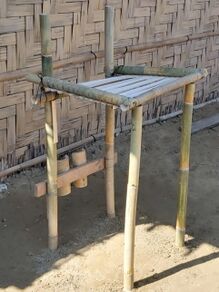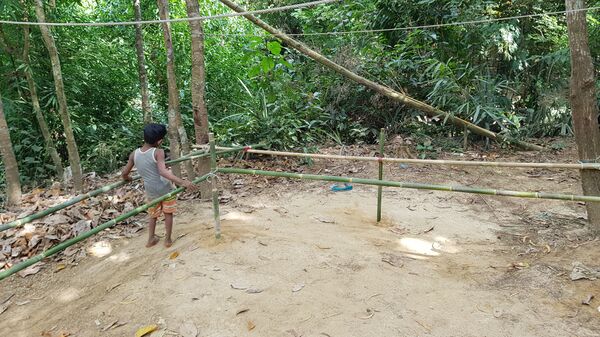Resource Mobilisation for Assistive Technology in Community Based Rehabilitation: Difference between revisions
No edit summary |
No edit summary |
||
| Line 15: | Line 15: | ||
To fulfil the unmet needs of [[Assistive Devices|assistive devices]] and technologies, rehabilitation professional can use locally available resources in an innovative way in [[Community Based Rehabilitation (CBR)|community based rehabilitation]]. This also strengthen the capacity of the community people to utilize the affordable and available resources to maximize the functional abilities of the individuals who require assistive devices, especially the mobility devices. It is also recommended during the [[What is Early Rehabilitation in Disasters and Conflicts|early rehabilitation in disasters and conflicts]]. | To fulfil the unmet needs of [[Assistive Devices|assistive devices]] and technologies, rehabilitation professional can use locally available resources in an innovative way in [[Community Based Rehabilitation (CBR)|community based rehabilitation]]. This also strengthen the capacity of the community people to utilize the affordable and available resources to maximize the functional abilities of the individuals who require assistive devices, especially the mobility devices. It is also recommended during the [[What is Early Rehabilitation in Disasters and Conflicts|early rehabilitation in disasters and conflicts]]. | ||
{{#ev:youtube|0Zosc8dEBf8|width}}<ref>Rachael Hope. Assistive Technology for Developmental Delays, Part 1. Available from: https://www.youtube.com/watch?v=0Zosc8dEBf8 [last accessed 22/11/2023]</ref> | {{#ev:youtube|0Zosc8dEBf8|width}}The video clearly described about the assistive devices and technologies, including how simple and tiny changes may bring a big change in life of person with disability.<ref>Rachael Hope. Assistive Technology for Developmental Delays, Part 1. Available from: https://www.youtube.com/watch?v=0Zosc8dEBf8 [last accessed 22/11/2023]</ref> | ||
== Materials can be used == | == Materials can be used == | ||
Revision as of 20:25, 22 November 2023
Introduction[edit | edit source]
According to recent report of WHO, it is estimated that 1.3 billion people – or 16% of the global population – experience a significant disability, and this number is growing day by day as the non-communicable diseases and people's life span increasing.[1]
Assistive devices and technology is linked with everyone in the world who experiences functional difficulties, either for short or long periods of time or permanently, including children and adults with disabilities, older people, and people living with chronic conditions. [2]
It is estimated that about 85-95% of people who need the assistive devices and technologies in low and middle income countries (LMICs) unable to access them. [3]
Purpose[edit | edit source]
The most commonly reported barrier to assistive products access is affordability and lack of availability, as well as expensiveness. A rapid assistive technology assessment (rATA) survey with individuals with disabilities in refugee camps in Cox’s Bazar District, Bangladesh, found that about half of the respondents reported unmet needs for assistive products. [2]
To fulfil the unmet needs of assistive devices and technologies, rehabilitation professional can use locally available resources in an innovative way in community based rehabilitation. This also strengthen the capacity of the community people to utilize the affordable and available resources to maximize the functional abilities of the individuals who require assistive devices, especially the mobility devices. It is also recommended during the early rehabilitation in disasters and conflicts.
The video clearly described about the assistive devices and technologies, including how simple and tiny changes may bring a big change in life of person with disability.[4]
Materials can be used[edit | edit source]
There are lots of locally available material's can be used as assistive devices. From my practical experience in community based rehabilitation for more than five years, here I am including a list of items which can be used to produce assistive devices or technologies locally and in a cost-effective manner.
The list includes, but not limited to,
- Bamboo
- Wood
- Rope
- Plastic bottle
- Branch of tree
- Cloth
- Cotton
- Foam
- Sandbag
- Mud
- Sand
- Old motor vehicle tyre, etc.
Bamboo wheelchair : A case presentation[edit | edit source]
The bamboo wheelchairs, also known as African Chairs by Ghanaian daily manual wheelchair users who tested the devices, adopt two designs: one for urban populations and another for rural areas. Both designs combined bamboo-rod skeletons, bonded by hot-glue gun, jointed and wrapped with epoxy-soaked fibres, then upholstered by a local tailor, with basic standard wheel components. An iterative design process which incorporated expert deliberations as well as feedback from users.[5]
For persons with disabilities in low-resource settings, barriers to mobility and physical activity are abrupt, due to various reasons like social stigmatization, the cost and adaptability of equipment. Bamboo wheelchairs have the potential to improve access to mobility and physical activity by allowing wheelchairs to be efficiently produced at cost, according to the user's needs. Interestingly, the bamboo wheelchairs can help reduce social stigma by avoiding the “medicalization” of wheelchairs and other traditional mobility devices.[5]
Resources[edit | edit source]
- Community-based rehabilitation: CBR guidelines by WHO
- Disabled Village Children By David Werner
- Early Rehabilitation in Conflict and Disasters Field Handbook, Humanity and Inclusion (HI)
- The Role of Physical Therapists in Disaster Management, World Physiotherapy
- Assistive technology in Tajikistan: situational analysis, WHO Europe, 2019.
References[edit | edit source]
- ↑ World Health Organization. Global report on health equity for persons with disabilities [Internet]. www.who.int. WHO; 2022 [cited 2023 Nov 22]. Available from: https://www.who.int/teams/noncommunicable-diseases/sensory-functions-disability-and-rehabilitation/global-report-on-health-equity-for-persons-with-disabilities
- ↑ 2.0 2.1 World Health Organization, Unicef. Global Report on Assistive Technology [Internet]. www.who.int. 2022 [cited 2023 Nov 22]. Available from: https://www.who.int/publications/i/item/9789240049451
- ↑ Matter R, Harniss M, Oderud T, Borg J, Eide AH. Assistive technology in resource-limited environments: a scoping review. Disability and Rehabilitation: Assistive Technology. 2016 Jul 21;12(2):105–14.
- ↑ Rachael Hope. Assistive Technology for Developmental Delays, Part 1. Available from: https://www.youtube.com/watch?v=0Zosc8dEBf8 [last accessed 22/11/2023]
- ↑ 5.0 5.1 Scheffers MF, Ona Ayala KE, Ottesen TD, Tuakli-Wosornu YA. Design and development of mobility equipment for persons with disabilities in low-resource and tropical settings: bamboo wheelchairs. Disability and Rehabilitation: Assistive Technology. 2019 Dec 3;16(4):1–7.








